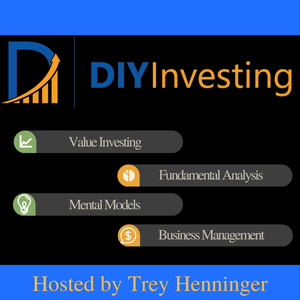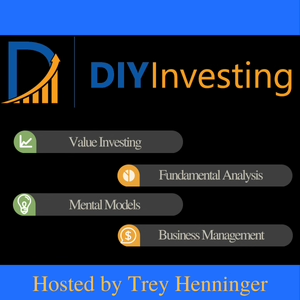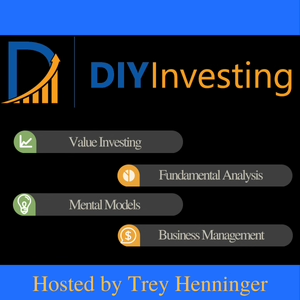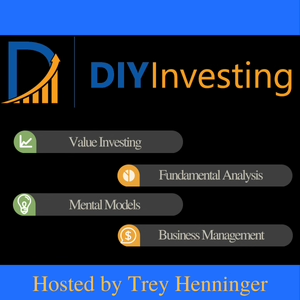
107 - Investing Goals for 2021
01/18/21 • 27 min
- Goals and Habits
- Concentration vs Diversification
- Signal vs Noise
If you enjoyed this podcast and found it helpful, please consider leaving me a rating and review. Your feedback helps me to improve the podcast and grow the show's audience.
Follow me on Twitter and YouTubeTwitter Handle: @TreyHenninger
YouTube Channel: DIY Investing
Support the Podcast on PatreonThis is a podcast supported by listeners like you. If you’d like to support this podcast and help me to continue creating great investing content, please consider becoming a Patron at DIYInvesting.org/Patron.
Show OutlineThe full show notes for this episode are available at https://www.diyinvesting.org/Episode107
2021 Investing Goals- Identify 2 new companies worthy of holding a 20% position in my portfolio
- Actually, build those new 10-20% positions by selling out of 2 of my current holdings. (I have already identified which ones to sell)
- Become more comfortable with high levels of concentration.
- My current largest holding is 35% of my portfolio. It's grown to this size from 20% and if all goes as I expect, it will likely continue to grow as a percentage of the portfolio. I need to become comfortable with 50% of my portfolio in a single stock if that company earns it through business performance.
- I may also sell 2 of my current positions before I have found the two new positions. Consequently, I need to tolerate holding less than 5 stocks for part of the year.
- Earn a 20% annual return for the year 2021.
- I earned a return of 22% in 2020, beating the S&P 500 by 3.7%.
- I believe I can match or exceed that return again this year.
- My discount rate is 10%, but that is used solely for the fundamental analysis portion of my stock analysis. With the current setup of my portfolio companies, I am often seeking 10% of the cash flows of the business, and an additional 10%+ from multiple expansion.
- I am optimistic that I can achieve this rate of return and perhaps substantially exceed it due to the types of companies I currently hold. We'll see how that comes to fruition.
- This is clearly an inferior goal as it is results based instead of process-based. I'm simply documenting it s that I have it as a reminder.
- Pass the Series 65 Exam
- Needed to become a Registered Investment Advisor
- Will allow me to take on clients interested in me managing their portfolio.
- If you'd like information about this and are perhaps interested in joining a waitlist, you can reach out for my information at my email: trey [at] diyinvesting.org
- Marketing Goals:
- 5,000 Twitter Followers (Currently just over 2k)
- 1,000 YouTube Subscribers (Currently just over 300)
- At least 1 outside investing client
- Useful research goals:
- Screen X number of companies this year (Say 100)
- Write-up 12 companies this year
- Read a 10k a day or a 10k a week, etc...
It used to be my goal during 2020 to move to only checking stock prices once a week.
Going forward, I will no longer have that as a goal. I have found that my focus on illiquid stocks means that I'm often monitoring stocks frequently because it takes a long time to build a stock position. If I had completed that prior goal, my results would have been worse.
Summary:In this episode, I outline my top investing goals for the new year. I aim to identify 2 new companies worth buying and my goal is to attain a 20%+ annual return for 2021. I also cover process-based goals relating to how to go about investing research. Finally, I would like to pass the Series 65 exam so that I can begin managing money for outside clients.
- Goals and Habits
- Concentration vs Diversification
- Signal vs Noise
If you enjoyed this podcast and found it helpful, please consider leaving me a rating and review. Your feedback helps me to improve the podcast and grow the show's audience.
Follow me on Twitter and YouTubeTwitter Handle: @TreyHenninger
YouTube Channel: DIY Investing
Support the Podcast on PatreonThis is a podcast supported by listeners like you. If you’d like to support this podcast and help me to continue creating great investing content, please consider becoming a Patron at DIYInvesting.org/Patron.
Show OutlineThe full show notes for this episode are available at https://www.diyinvesting.org/Episode107
2021 Investing Goals- Identify 2 new companies worthy of holding a 20% position in my portfolio
- Actually, build those new 10-20% positions by selling out of 2 of my current holdings. (I have already identified which ones to sell)
- Become more comfortable with high levels of concentration.
- My current largest holding is 35% of my portfolio. It's grown to this size from 20% and if all goes as I expect, it will likely continue to grow as a percentage of the portfolio. I need to become comfortable with 50% of my portfolio in a single stock if that company earns it through business performance.
- I may also sell 2 of my current positions before I have found the two new positions. Consequently, I need to tolerate holding less than 5 stocks for part of the year.
- Earn a 20% annual return for the year 2021.
- I earned a return of 22% in 2020, beating the S&P 500 by 3.7%.
- I believe I can match or exceed that return again this year.
- My discount rate is 10%, but that is used solely for the fundamental analysis portion of my stock analysis. With the current setup of my portfolio companies, I am often seeking 10% of the cash flows of the business, and an additional 10%+ from multiple expansion.
- I am optimistic that I can achieve this rate of return and perhaps substantially exceed it due to the types of companies I currently hold. We'll see how that comes to fruition.
- This is clearly an inferior goal as it is results based instead of process-based. I'm simply documenting it s that I have it as a reminder.
- Pass the Series 65 Exam
- Needed to become a Registered Investment Advisor
- Will allow me to take on clients interested in me managing their portfolio.
- If you'd like information about this and are perhaps interested in joining a waitlist, you can reach out for my information at my email: trey [at] diyinvesting.org
- Marketing Goals:
- 5,000 Twitter Followers (Currently just over 2k)
- 1,000 YouTube Subscribers (Currently just over 300)
- At least 1 outside investing client
- Useful research goals:
- Screen X number of companies this year (Say 100)
- Write-up 12 companies this year
- Read a 10k a day or a 10k a week, etc...
It used to be my goal during 2020 to move to only checking stock prices once a week.
Going forward, I will no longer have that as a goal. I have found that my focus on illiquid stocks means that I'm often monitoring stocks frequently because it takes a long time to build a stock position. If I had completed that prior goal, my results would have been worse.
Summary:In this episode, I outline my top investing goals for the new year. I aim to identify 2 new companies worth buying and my goal is to attain a 20%+ annual return for 2021. I also cover process-based goals relating to how to go about investing research. Finally, I would like to pass the Series 65 exam so that I can begin managing money for outside clients.
Previous Episode

106 - When to Sell Stocks
Mental Models discussed in this podcast:
- Opportunity Cost
- Rebalancing
- Coffee Can Portfolio
- Intrinsic Value
- Optionality
If you enjoyed this podcast and found it helpful, please consider leaving me a rating and review. Your feedback helps me to improve the podcast and grow the show's audience.
Follow me on Twitter and YouTubeTwitter Handle: @TreyHenninger
YouTube Channel: DIY Investing
Support the Podcast on PatreonThis is a podcast supported by listeners like you. If you’d like to support this podcast and help me to continue creating great investing content, please consider becoming a Patron at DIYInvesting.org/Patron.
Show OutlineThe full show notes for this episode are available at https://www.diyinvesting.org/Episode106
When should I sell stocks? (Question from Patron)There are a few key considerations:
- Opportunity Cost
- What else do you own?
- What is your current best idea? How much of it do you own?
- Trimming Positions
- I don't like doing this. All-or-nothing for me.
- There is a huge difference between selling into cash versus selling to buy a new stock
- Perhaps you consider selling to cash at a P/E of 35, but otherwise only sell if you have a better stock to put it in.
- I may be fine selling a stock at a P/E of 20 (that I think is worth 25) and buying a stock at a P/E of 5 (that I think is worth a P/E of 15). My return prospects are better.
You should sell a stock if you've made a mistake. If you were wrong about the thesis or your thesis has broken you should sell.
This is hard to do and I struggle to do so myself, especially if the price has fallen substantially.
Other Considerations:- Coffee Can Portfolio
- Seeking "Never Sell" stocks - only certain companies qualify
- Benefits from a deferred tax liability (can become quite significant over time)
- Preferable for individual investors. hard to implement professionally.
- Return Differential
- Don't sell a stock because a new idea is 1% better.
- You want at least a 5% return differential.
- Future returns are 5% when the new idea is 10%
- OR future returns are 10% when the new idea is 15%.
- Don't quibble over small differences because those differences are within your margin of error.
- Question from Patron: "Should I buy great companies during their growth phase and then sell when they lose their advantages?"
- A few problems here.
- It is difficult to predict when a company will lose its advantages.
- Likewise, once a company is recognized to have lost its advantages, usually, the price deterioration has already occurred.
- If you want to maximize profits, you likely need to sell BEFORE advantages have been lost.
- Positive Optionality and Selling Above Intrinsic Value
- It is almost impossible to accurately calculate intrinsic value.
- Consequently, it is likely a mistake to sell when a company reaches your calculated intrinsic value.
Many value investors lack a clear strategy on when to sell stocks in their portfolio. This decision ought to be based on opportunity cost, potential investment mistakes, intrinsic value, and return differential between old and new companies.
Next Episode

108 - Coffee Can Portfolio Investing
Mental Models discussed in this podcast:
- Deferred Tax Liability
- Skin-in-the-game
If you enjoyed this podcast and found it helpful, please consider leaving me a rating and review. Your feedback helps me to improve the podcast and grow the show's audience.
Follow me on Twitter and YouTubeTwitter Handle: @TreyHenninger
YouTube Channel: DIY Investing
Support the Podcast on PatreonThis is a podcast supported by listeners like you. If you’d like to support this podcast and help me to continue creating great investing content, please consider becoming a Patron at DIYInvesting.org/Patron.
Show OutlineThe full show notes for this episode are available at https://www.diyinvesting.org/Episode108
Coffee Can Portfolio- Seeking "Never Sell" stocks - only certain companies qualify
- Benefits from a deferred tax liability (Can become quite significant over time)
- Preferable for individual investors. Hard to implement professionally
- An industry that lacks disruption risk
- Banking (Example)
- Stable and high returns on capital/equity (15% or higher)
- Long-term sustainable organic growth of at least 5% but preferably 10-15%. (You don't necessarily want 20%+ growers that will eventually lose all growth)
- Low competition, could be regulated monopoly or oligopoly
- Founder led company or a long-term CEO with skin-in-the-game
- Zero or low debt/leverage policies
- The ability to be a ten-bagger or a 100-bagger
- Usually small with the ability to grow large.
- A small competitor with a competitive advantage (cost perhaps) over larger competitors in a big market.
- Think early Walmart, Costco, Home Depot, GEICO
- Intelligent capital allocation strategies that benefit shareholders
- Lack of dilution
- Growing dividends or buybacks over time (Dividend Champion type stocks)
- Unless it is a roll-up strategy, an average to acquisitions can be helpful, because they often destroy shareholder value.
- You are a true business owner
- Judge your success by the performance of individual companies, not the overall portfolio return.
- Logical point: If every individual company compounds at 10% per year or more, then the portfolio as a whole by definition must also compound by at least 10% per year.
- Position sizing no longer matters. Your greatest winners may eventually become 50%, 75%, or 90% of your total portfolio. That's okay. That's how the strategy works. This is how the strategy outperforms.
- Buy one new stock a year, each year you work.
- Put all of your savings for the year into that company.
- Never sell.
- Ideally register for the shares in direct certificate form. It can be electronically held at a transfer agent, but after the year, don't hold the shares directly with a stockbroker.
- This limits your ability to sell the shares and is a huge psychological boost in implementing the strategy.
In this episode, I discuss the coffee can portfolio approach to investing. This investing strategy involves never selling a stock once it is bought. Therefore, you must seek high-quality companies with long runways for growth and high returns on capital.
If you like this episode you’ll love
Episode Comments
Generate a badge
Get a badge for your website that links back to this episode
<a href="https://goodpods.com/podcasts/the-diy-investing-podcast-15422/107-investing-goals-for-2021-13037572"> <img src="https://storage.googleapis.com/goodpods-images-bucket/badges/generic-badge-1.svg" alt="listen to 107 - investing goals for 2021 on goodpods" style="width: 225px" /> </a>
Copy




